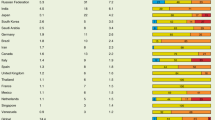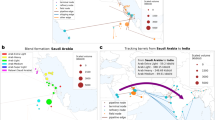Abstract
Purpose
Recently, using a long-run refinery simulation model, Bredeson et al. conclude that the light transportation fuels have roughly the same CO2 footprint. And, any allocation scheme which shows substantial difference between gasoline and diesel CO2 intensities must be seen with caution. The purpose of this paper is to highlight the inappropriate modeling assumptions which lead to these inapplicable conclusions into the current oil refining context.
Methods
From an economic point of view, optimization models are more suitable than simulation tools for providing decision policies. Therefore, we used a calibrated refinery linear programming model to evaluate the impact of varying the gasoline-to-diesel production ratio on the refinery's CO2 emissions and the marginal CO2 intensity of the automotive fuels.
Results and discussion
Contrary to Bredeson et al.'s conclusions, our results reveal that, within a calibrated optimization framework, total and per-product CO2 emissions could be affected by the gasoline-to-diesel production ratio. More precisely, in a gasoline-oriented market, the marginal CO2 footprint of gasoline is significantly higher than diesel, while the opposite result is observed within a diesel-oriented market. These two scenarios could reflect to some extent the American and the European oil refining industry for which policy makers should adopt a different per-product taxation policy.
Conclusions
Any relevant and economic ground CO2 policies for automotive fuels should be sensitive to the environmental consequences associated with their marginal productions. This is especially true in disequilibrium markets where the average and marginal reactions could significantly differ. Optimization models, whose optimal solution is fully driven by marginal signals, show that the refinery's global and/or per-product CO2 emissions could be affected by the gasoline-to-diesel production ratio.
Similar content being viewed by others
References
Azapagic A, Clift R (1998) Linear programming as a tool in life cycle assessment. Int J Life Cycle Assess 6(3):305–316
Azapagic A, Clift R (1999) Allocation of environmental burdens in co-product systems: product-related burdens (part 1). Int J Life Cycle Assess 6(4):357–369
Azapagic A, Clift R (2000) Allocation of environmental burdens in co-product systems: process and product-related burdens (part 2). Int J Life Cycle Assess 5(1):31–36
Bartelmus P (2008) Quantitative eco-nomics. Springer, The Netherlands
Bredeson L, Quiceno-Gonzalez R, Riera-Palou X, Harrison A (2010) Factors driving refinery CO2 intensity, with allocation into products. Int J Life Cycle Assess 15:817–826
Furoholt E (1995) Life cycle assessment of gasoline and diesel. Resourc Conserv Recy 14:251–263
International Energy Agency (2012) World energy outlook 2012
Jess A (1996) Der Energieverbrauch zur Herstellung von Mineralölprodukten. Erdöl-Erdgas-Kohle 112(5):201–205
JRC/IES, EUCAR, CONCAWE (2011) Well-to-wheels analysis of future automotive fuels and powertrains in the European context, WELL-to-TANK Report—Appendix 3, Version 3c, July 2011
Jungbluth N (2007) Erdöl. In: Dones R (ed) Sachbilanzen von Energiesystemen: Grundlagen für den ökologischen Vergleich von Energiesystemen und den Einbezug von Energiesystemen in Ökobilanzen für die Schweiz. Ecoinvent report No. 6-IV, Swiss Centre for Life Cycle Inventories, Duebendorf, Switzerland
KBC (2012) Outlook for the world refining industry 2012
Palou-Rivera I et al. (2011) Updated estimation of energy efficiencies of US petroleum refineries. Center for Transportation Research, Argonne National Laboratory, Argonne
PE International (2007) GaBi modelling principles, GaBi Software, product sustainability, 2007
Pinto JM, Joly M, Moro LFL (2000) Planning and scheduling models for refinery operations. Comput Chem Eng 24:2259–2276
Purvin & Gertz (2008) Study on oil refining and oil markets. Prepared for European Commission
Tehrani Nejad MA (2007) Allocation of CO2 emissions in petroleum refineries to petroleum joint products: a linear programming model for practical application. Energ Econ 29:974–997
Tehrani Nejad MA, Saint-Antonin V (2008) Impact of tightening the sulfur specifications on the automotive fuels' CO2 contribution: a French refinery case study. Energy Policy 36(7):2293–2770
Tehrani Nejad MA (2010) Allocating the CO2 emissions of an oil refinery with Aumann-Shapley prices: comment. Energ Econ 32(1):243–255
Tillman AM (2000) Significance of decision-making for LCA methodology. Environ Impact Assess Rev 20(1):113–123
Wang M, Lee H, Molburg J (2004) Allocation of energy use in petroleum refineries to petroleum products: implications for life-cycle energy use and emission inventory of petroleum transportation fuels. Int J Life Cycle Assess 9(1):34–44
Zamagni A, Guinée J, Heijungs R, Masoni P, Raggi A (2012) Lights and shadows in consequential LCA. Int J Life Cycle Assess 17(7):904–918
Acknowledgments
The authors would like to acknowledge Frederique Bouvart (IFPEN) for proving a number of helpful observations and valuable comments on this paper.
Author information
Authors and Affiliations
Corresponding author
Additional information
Responsible editor: Matthias Finkbeiner
This is a personal research and does not represent the views of any public or private company in France.
Rights and permissions
About this article
Cite this article
Tehrani Nejad M., A., Saint-Antonin, V. Factors driving refinery CO2 intensity, with allocation into products: comment. Int J Life Cycle Assess 19, 24–28 (2014). https://doi.org/10.1007/s11367-013-0634-9
Received:
Accepted:
Published:
Issue Date:
DOI: https://doi.org/10.1007/s11367-013-0634-9




